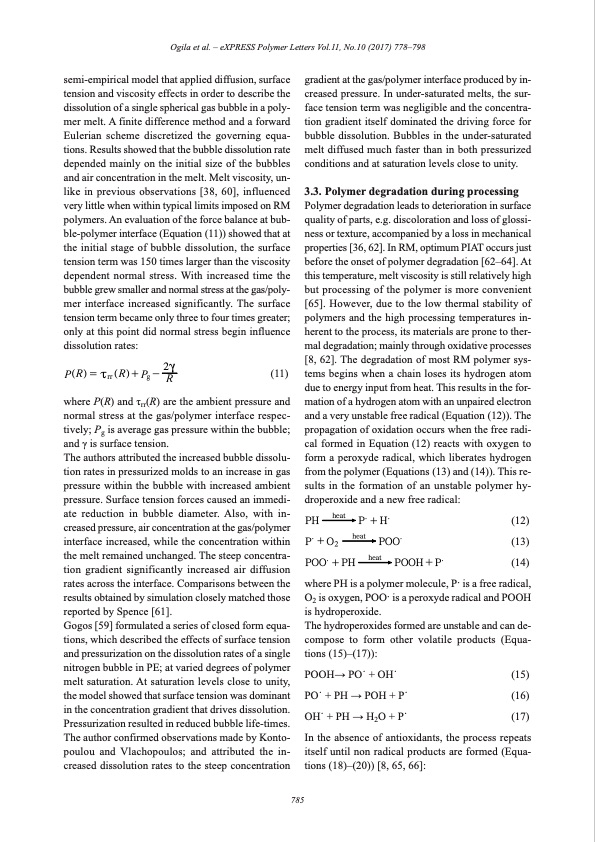
PDF Publication Title:
Text from PDF Page: 009
2c PQRV=xrrQRV+Pg- R (11) Ogila et al. – eXPRESS Polymer Letters Vol.11, No.10 (2017) 778–798 semi-empirical model that applied diffusion, surface tension and viscosity effects in order to describe the dissolution of a single spherical gas bubble in a poly- mer melt. A finite difference method and a forward Eulerian scheme discretized the governing equa- tions. Results showed that the bubble dissolution rate depended mainly on the initial size of the bubbles and air concentration in the melt. Melt viscosity, un- like in previous observations [38, 60], influenced very little when within typical limits imposed on RM polymers. An evaluation of the force balance at bub- ble-polymer interface (Equation (11)) showed that at the initial stage of bubble dissolution, the surface tension term was 150 times larger than the viscosity dependent normal stress. With increased time the bubble grew smaller and normal stress at the gas/poly- mer interface increased significantly. The surface tension term became only three to four times greater; only at this point did normal stress begin influence dissolution rates: gradient at the gas/polymer interface produced by in- creased pressure. In under-saturated melts, the sur- face tension term was negligible and the concentra- tion gradient itself dominated the driving force for bubble dissolution. Bubbles in the under-saturated melt diffused much faster than in both pressurized conditions and at saturation levels close to unity. 3.3. Polymer degradation during processing Polymer degradation leads to deterioration in surface quality of parts, e.g. discoloration and loss of glossi- ness or texture, accompanied by a loss in mechanical properties [36, 62]. In RM, optimum PIAT occurs just before the onset of polymer degradation [62–64]. At this temperature, melt viscosity is still relatively high but processing of the polymer is more convenient [65]. However, due to the low thermal stability of polymers and the high processing temperatures in- herent to the process, its materials are prone to ther- mal degradation; mainly through oxidative processes [8, 62]. The degradation of most RM polymer sys- tems begins when a chain loses its hydrogen atom due to energy input from heat. This results in the for- mation of a hydrogen atom with an unpaired electron and a very unstable free radical (Equation (12)). The propagation of oxidation occurs when the free radi- cal formed in Equation (12) reacts with oxygen to form a peroxyde radical, which liberates hydrogen from the polymer (Equations (13) and (14)). This re- sults in the formation of an unstable polymer hy- droperoxide and a new free radical: where P(R) and τrr(R) are the ambient pressure and normal stress at the gas/polymer interface respec- tively; Pg is average gas pressure within the bubble; and γ is surface tension. The authors attributed the increased bubble dissolu- tion rates in pressurized molds to an increase in gas pressure within the bubble with increased ambient pressure. Surface tension forces caused an immedi- ate reduction in bubble diameter. Also, with in- creased pressure, air concentration at the gas/polymer interface increased, while the concentration within the melt remained unchanged. The steep concentra- tion gradient significantly increased air diffusion rates across the interface. Comparisons between the results obtained by simulation closely matched those reported by Spence [61]. Gogos [59] formulated a series of closed form equa- tions, which described the effects of surface tension and pressurization on the dissolution rates of a single nitrogen bubble in PE; at varied degrees of polymer melt saturation. At saturation levels close to unity, the model showed that surface tension was dominant in the concentration gradient that drives dissolution. Pressurization resulted in reduced bubble life-times. The author confirmed observations made by Konto- poulou and Vlachopoulos; and attributed the in- creased dissolution rates to the steep concentration PH heat P$ + H$ (12) $ heat $ P +O2 POO (13) POO$ + PH heat POOH + P$ (14) where PH is a polymer molecule, P· is a free radical, O2 is oxygen, POO· is a peroxyde radical and POOH is hydroperoxide. The hydroperoxides formed are unstable and can de- compose to form other volatile products (Equa- tions (15)–(17)): POOH→ PO ̇ + OH ̇ (15) PO ̇ + PH → POH + P ̇ (16) OH ̇ + PH → H2O + P ̇ (17) In the absence of antioxidants, the process repeats itself until non radical products are formed (Equa- tions (18)–(20)) [8, 65, 66]: 785PDF Image | Rotational molding: A review

PDF Search Title:
Rotational molding: A reviewOriginal File Name Searched:
Rotational_molding_A_review_of_the_models_and_mate.pdfDIY PDF Search: Google It | Yahoo | Bing
Development of a solar powered Electric Ship The Electricship website originally started off as a project to develop a comprehensive renewable, affordable, modular electric ship... More Info
Modular Boat Hull Composite The case for a unsinkable, modular composite hybrid boat hull... More Info
MS Burgenstock Hybrid Electric Catamaran Lake Lucerne Unique shuttle servicing Lucerne to the Burgenstock Resort... More Info
Ground Power Unit GPU Powered by Lithium Ion Batteries The goal of the Ground Power Unit is to provide a readily accessible, modular, ready-to-power solution for remote power... More Info
| CONTACT TEL: 608-238-6001 Email: greg@electricship.com | RSS | AMP |